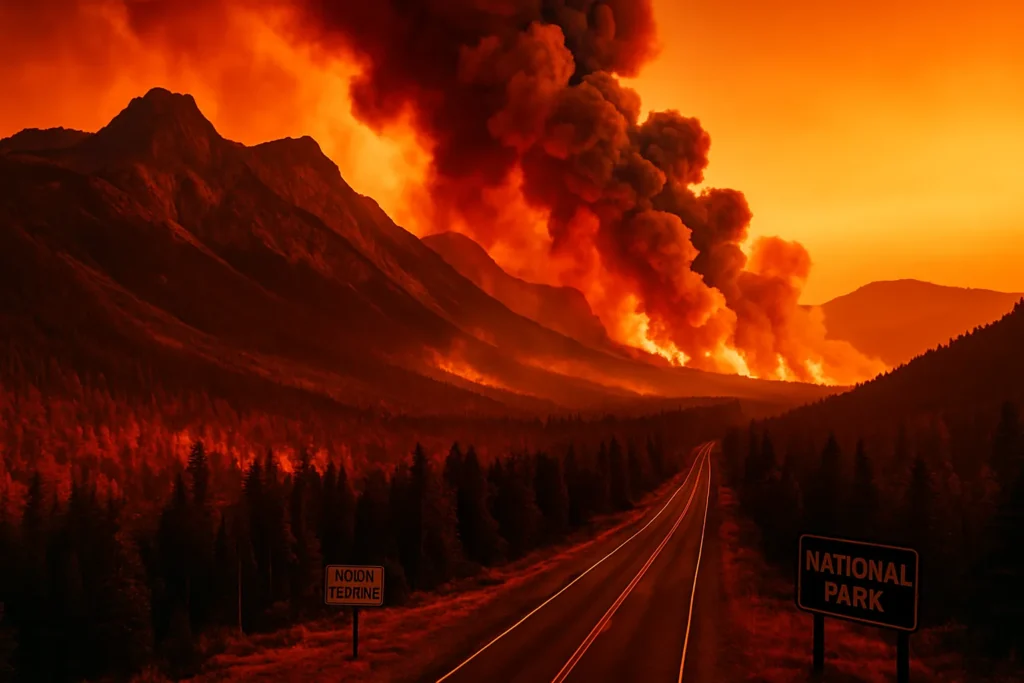Rapidly Growing Wildfires Prompt Evacuations and Closures
Increasing wildfire activity along Colorado’s Western Slope has resulted in significant evacuations and park closures, as multiple fires continue to burn. Notably, the Mountain View Fire in Chaffee County, Colorado, has already destroyed two homes and burned more than 60 acres. Currently, fifty homes remain within an evacuation zone as firefighting teams strive to keep the flames contained. Officials declared Friday as a no-burn day in unincorporated Chaffee County due to constrained firefighting resources. Thankfully, the fire hasn’t yet reached public lands, and no injuries have been reported thus far.
Simultaneously, two separate fires have ignited within the Black Canyon of Gunnison National Park, leading to immediate evacuations of all visitors and park staff. The largest of these, the South Rim Fire, has already engulfed over 1,640 acres and remains entirely uncontained. The National Park Service believes lightning strikes from a recent thunderstorm initiated the fires, fueled by dry vegetation and conditions characterized by high winds and extremely dry air.
Montrose County is currently operating under Stage 1 fire restrictions, limiting certain activities to minimize further wildfire risks. Given these conditions, fire crews from across Colorado have converged on the region to control the spreading flames, employing aerial retardant drops and creating protective firebreaks to safeguard critical infrastructure within the park.
“Our primary focus is protecting human life, property, and critical park infrastructure,” stated an official from the National Park Service, emphasizing ongoing efforts to construct defensive lines and conduct strategic retardant drops.
Firefighters Face Challenging Conditions
Efforts to combat these wildfires have been complicated by severe weather conditions inherent to Colorado during the summer months. High temperatures reaching the 90s Fahrenheit, coupled with low humidity levels and gusty winds, have exacerbated fire behavior. This combination has made containment particularly challenging as flames rapidly advance, consuming dry grasses, trees, and other vegetation.
In Black Canyon of the Gunnison National Park, firefighters have employed aircraft to strategically disperse retardants and protect key locations such as the visitor center. Crews preemptively removed dry vegetation around sensitive areas, coating buildings with fire retardant to reduce vulnerability to embers and heat. Despite these efforts, the volatile weather conditions continue to challenge firefighters, raising concerns that the fires could expand further.
Local emergency services, including the Colorado State Patrol and Colorado Division of Fire Prevention and Control, are actively assisting with evacuation procedures and firefighting operations. Authorities remain vigilant and have cautioned residents and visitors alike to be prepared for the possibility of rapid changes in fire direction and behavior.
“Conditions are extremely unpredictable with shifting winds. We’re urging everyone in affected areas to stay informed and ready for possible rapid evacuations,” explained a Colorado fire management spokesperson.
On a broader scale, the regional firefighting teams are coordinated through an incident command structure, enabling them to pool resources and direct assistance to the most critical areas efficiently. However, containment remains elusive as unpredictable winds continue to fan the flames, posing a considerable threat to additional homes and infrastructure.
Regional Context and Implications of Increasing Wildfire Activity
The recent fires on Colorado’s Western Slope occur against a backdrop of intensifying wildfire trends throughout the western United States, largely attributed to ongoing drought conditions and rising global temperatures. Studies indicate that climate change significantly contributes to longer, hotter, and drier summers, which subsequently elevate wildfire risks across dry environments such as Colorado’s landscapes.
Historically, the Black Canyon of the Gunnison has witnessed numerous wildfire incidents. However, the frequency and intensity of these events have notably increased over recent years. In 2020, wildfires scorched vast stretches of Colorado, marking one of the worst wildfire seasons on record. Experts concur that such incidents are likely to become more common without significant intervention or changes in environmental policy and wildfire management approaches.
Wildfires in Colorado increasingly pose significant economic and ecological consequences, impacting tourism revenue, air quality, public health, and local ecosystems. National parks like Black Canyon are popular tourist destinations, attracting visitors for their natural beauty and outdoor recreation opportunities. Closures due to wildfires substantially impact local economies, leading to decreased visitor spending in nearby towns reliant on tourism.
The broader policy implication of these intensified wildfire occurrences underscores the urgent need for improved fire management strategies, increased funding for firefighting resources, and greater community preparedness measures. Colorado and federal authorities are continuously evaluating policies and practices around wildfire mitigation, forest management, and emergency response to adapt to this escalating risk.
“We need to strengthen our wildfire management policies and invest significantly in prevention and mitigation measures to reduce the risks posed by future wildfires,” says Dr. Lila Monroe, an expert in environmental policy and wildfire management.
As firefighting efforts continue, residents in affected areas along the Western Slope remain on alert, closely monitoring developments and preparing for potential changes in evacuation directives. Authorities emphasize the importance of adherence to fire restrictions and urge community members to maintain readiness throughout the ongoing wildfire season.


